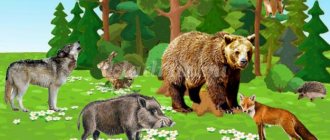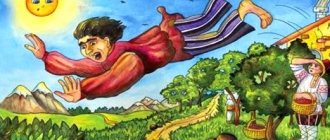Progress of the lesson.
Round dance game . “Let’s go to the garden for raspberries”
.
Class.
- What fairy tale did we want to play today? ( Spikelet )
- Who came up with this fairy tale ? (People of Ukraine)
- So this is a Ukrainian folk tale .
- Who will take care that the audience has fun in the theater? (Artists)
— Why do spectators come to the theater? (Watch a fairy tale , relax)
— Spectators should get ready for the theater, comb their hair, get themselves in order. Dress up, take your bags. Someone can go to the theater with their child. So the audience, this is a very important role.
— The first call, what does it mean? (You need to hurry up, the performance will start soon, the artists are going to take their places on the stage)
— The second call, what does it mean? (Spectators should take their seats )
- And what does the third call mean? (The show is about to start)
.
- What kind of fairy tale will we show ? ( Spikelet )
- Go, get ready for the game.
Narrator : Good afternoon, dear viewers! Today the artists of our theater will show you the fairy tale “ Spikelet ”
Dramatization game . (According to the text of the fairy tale )
Narrator : That’s the end of the fairy tale , and whoever listened, well done! The artists who took part in the performance were:
— Mouse Krut – Full name.
— Mouse Vert – Full name.
- Cockerel - loud throat - full name.
— Narrator – F. AND ABOUT.
- This is the kind of fairy tale we have . Did you like it?
-Who did you like the most?
- What were the Mice like in this fairy tale ? And Cockerel?
— Were the audience grateful to the artists? Did you give applause and flowers?
— Did you like playing in the theater ?
— What fairy tale will we show next time?
— Next time, let’s open a cafe in the theater, would you like? (Yes)
- Now let’s have a little fun. (Musical game “Tuchka”
)
Game-dramatization of the fairy tale “Teremok” in the first junior group “Game-dramatization of the fairy tale “Teremok” in the 1st junior group Purpose: To develop children’s interest in theatrical play, their creative abilities.
Lesson summary “Telling the fairy tale “Spikelet” using a finger theater and a bibabo doll” Purpose: to introduce children to the content of the Ukrainian folk tale “Spikelet”. Educational objectives: to develop the ability to answer.
Photo report “Dramatization of the fairy tale “Cinderella”” On May 17, on the territory of our kindergarten, a regional methodological association was held for heads on the topic “Modern approaches to organization. A dramatization game based on the Indian folk tale “Princess Mak” in the preparatory group. Photo report Performance based on the Indian folk tale “Princess Mak”. Purpose: To develop in children of senior preschool age the ability to see beauty. Summary of educational activities for students of the senior group “How is a performance created? Dramatization of the fairy tale "Kolobok" Objectives of the educational areas: "Educational": To introduce children to the process of creating a play, professions in the theater (director, artist,. Summary of an open lesson for preschoolers with disabilities "Game - dramatization of the fairy tale "Turnip" Goal: Formation of communication abilities in preschoolers with disabilities using theatrical activities.Objectives: 1. Educational.
Source
Lesson summary “Retelling the fairy tale “Spikelet” with elements of dramatization
Olga Podolskaya
Lesson summary “Retelling the fairy tale “Spikelet” with elements of dramatization
Topic: Retelling of the Ukrainian folk tale “ Spikelet ”
with
elements of dramatization
Objectives: 1 Learn to retell , look for answers to questions in the text, promote the development of coherent, logical speech. 2 enrichment of the dictionary (wheat, thresh, automate the delivered sounds, introduce them into independent speech. 3. Develop the prosodic aspects of speech: timbre of the voice, its strength, tempo, intonation, expressiveness. 4. development of logical thinking; conclusion of the moral of the tale 5. promote the development positive character traits (desire to help, empathy , kindness)
.
ECD Reading the Ukrainian folk tale “Spikelet”
ECD Reading the Ukrainian folk tale “Spikelet”
Summary of direct educational activities Educational area “Speech development” section “Reading fiction”
Topic: Reading the Ukrainian folk tale “Spikelet”
Educator: Deeva L.A.
Goal: To introduce children to the Ukrainian folk tale “Spikelet”.
-Teach to monitor the development of action;
— Teach children to evaluate the actions of heroes;
— Learn to answer questions about the content of the fairy tale.
— Develop attention, memory, intonation expressiveness.
— Cultivate interest in other fairy tales of the peoples of the world, hard work.
Material: illustrations for a fairy tale, picture of a spikelet.
Educator: I’ll tell you a fairy tale where the cockerel ate pies alone, and then you’ll tell me why when you listen to the fairy tale. This fairy tale is called "Spikelet".
The teacher tells a fairy tale and shows illustrations based on the fairy tale.
- Why did the cockerel eat only the pies?
- What did the little mice propose to do?
- Who threshed the spikelet?
— What did the little mice propose to do with the grain?
- What were Krut and Vert doing at that time?
— Who was the first to sit down at the table when the pies were ready?
— Why did the little mice’s voices become quieter after each question from the cockerel? (They were ashamed). Why?
- Why didn’t the cockerel take pity on the mice when they left the table?
- How would you portray the little mice when they found out that the cockerel would not treat them to pies?
Educator: That's right, they felt ashamed.
— How does the fairy tale end, with what words?
- What a cockerel (hardworking).
The children repeat the word “hardworking” in chorus and individually.
Educator: You listened to the fairy tale well, you can play.
Educator: A spikelet is an inflorescence that contains a fruit - a grain, and a stalk is a straw. (The teacher shows the spikelet).
-Let's show how spikelets grow.
In the spring, the field was plowed (the children make sliding movements of their palms against each other
The sun is hot, (they cross their palms, spread their fingers, and raise
Warms the earth. (They lower their hands, making springy movements with their palms,
The spikelets rose high, (Bend their arms at the elbows, turn their palms towards each other).
They are drawn to the sun. (Slowly raise their hands.)
The wind blows, (Swing their arms above their heads).
Bent to the right, (Tilt the body and arms to the right, to the left).
And as the rain falls, (They slowly lower their hands, quickly moving their fingers).
What a field! (Raise their hands, fingers spread.)
How beautiful! (Shake hands above head).
Educator: We found out that flour is made from grains, and what is baked from flour?
— That’s right, not only various pies are baked from flour, but also bread. And you and I know that bread can be made from wheat and rye.
Educator: Listen, I’ll read you the end of the fairy tale again. Just listen carefully, then you will stage it.
The teacher reads the last dialogue with the words: “The pies were baked...”
Children's dramatization of an excerpt from a fairy tale.
Educator: What fairy tale did we meet today?
Educator: Which fairy tale hero would you like to be like? Who didn't you like in the fairy tale? Why?
—What does a fairy tale teach us?
Educator: This is where our journey through the fairy tale ends. Well done, you all listened carefully to the story.
Source
Leave your comment
Rosobrnadzor: almost half of teachers do not reach the basic level of training
Reading time: 2 minutes
A third of Russians have not read a single book in six months
Reading time: 1 minute
Watching TV impairs cognitive function
Reading time: 3 minutes
Early start of classes negatively affects student performance
Reading time: 2 minutes
An Italian teacher gave children a summer assignment and became famous
Reading time: 4 minutes
The Ministry of Education has prepared a concept for a digital student profile project
Reading time: 1 minute
Gift certificates
Responsibility for resolving any controversial issues regarding the materials themselves and their contents is taken by the users who posted the material on the site. However, the site administration is ready to provide all possible support in resolving any issues related to the work and content of the site. If you notice that materials are being used illegally on this site, please notify the site administration using the feedback form.
All materials posted on the site were created by the authors of the site or posted by users of the site and are presented on the site for informational purposes only. Copyrights for materials belong to their legal authors. Partial or complete copying of site materials without written permission from the site administration is prohibited! The opinion of the administration may not coincide with the point of view of the authors.
Source
Lesson summary “Game-dramatization of the fairy tale “Spikelet”
Olga Valieva
Lesson summary “Game-dramatization of the fairy tale “Spikelet”
- teach children to convey the character of heroes;
- promote the development of children's interest in theatrical play through active involvement in play activities;
— develop children’s speech, thinking, memory, and creative abilities;
- cultivate a love of fairy tales .
Equipment: 5 bowls; 3 cups; 3 spoons; rooster and mouse masks; firewood; axe; pies; broom; bag.
Preliminary work: Reading the fairy tale “ Spikelet ”, analysis of the characters of the fairy tale ; choice of artists; conversations about the theater.
On the topic: methodological developments, presentations and notes
Summary of a speech development lesson on teaching children to retell. The lesson is based on techniques for using reference pictures to facilitate the process of retelling a literary work and closing.
Moral education. “Work feeds, but laziness spoils.”
Summary of a lesson on a game-dramatization based on the Ukrainian folk tale “Spikelet”. This lesson is aimed at children’s emotional perception of the figurative content of the fairy tale, comprehending the characters and.
A dramatization of the fairy tale “Spikelet” can be used as part of a final lesson to reinforce the topic of bread. The older children and I love to show dramatization for the younger groups. Let's get acquainted with the village.
I present to your attention a presentation of the fairy tale “Spikelet” for the middle group.
This material introduces children to a new fairy tale, teaches them to follow the development of the action, characterize the actions of the characters, and form their attitude towards the characters.
Summary of the GCD in the middle group for familiarization with fiction, reading the Ukrainian folk tale “Spikelet” with the transition to the application “Pie” Purpose: 1. to introduce d.


